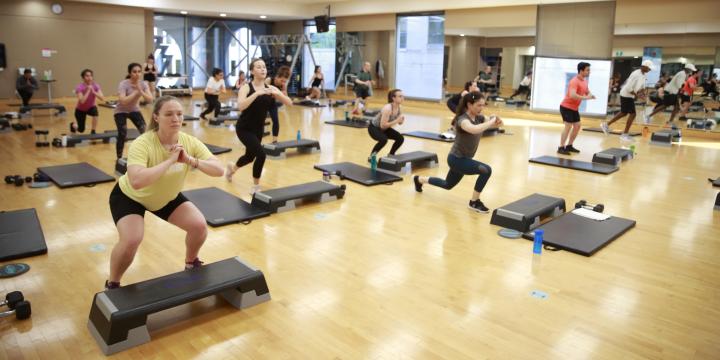
Earlier this spring, the YWCA Health + Fitness team invited volunteers and instructors to a full-day workshop. It was an opportunity for all of us to learn and share the latest tools and techniques of the industry.
Katherine Taylor, a kinesiologist and personal trainer at the YWCA Heath + Fitness Centre, gave a great presentation on foam rollers. You may have seen members use these in the stretching areas and wondered what they're up to.
Foam rollers used to be reserved for elite athletes and physical therapy; these days, many active people use rollers as part of their regular fitness routine.
What is fascia?
There is a thick layer of tissue, known as fascia, that surrounds all of our muscles, organs, and bones, and acts as a webbing that connects everything together in our body. Fascia, which Katherine describes is like a sausage casing or Saran wrap all over your body. Due to activity and movement patterns such as sitting too much or postural irregularities, the fascia can become glued together in certain areas. When it becomes tight, we experience a loss of mobility, flexibility and it can often lead to injury and pain.
The science now is clear that we need to both stretch and roll out our muscles for injury prevention and overall health.
Using foam rollers
Foam rollers are designed to help release tightness and pain in our bodies by increasing blood flow through the fascia. It's similar to a deep tissue massage in releasing the tightly glued portions of our fascial tissues. Katherine says the purpose of foam or ball rolling is to “apply pressure to muscular tissue to eliminate scar tissue and soft-tissue adhesions by freeing up the tissue, and allowing it to move smoothly around surrounding structures.”
Foam rolling is like “Rolling out pizza dough with a pin roller,” she adds. The idea is to smooth out the fascia. When we roll we are rolling out the lumps of the dough to make a nice pizza crust, just like how we roll out the tight glued together parts of our fascia to create a flexible supple connective tissue.
Tips & tricks
To speed up your recovery time and increase your range of motion, as well as prepare your muscles for a good workout, Katherine offers the following tips for using foam rollers:
- Do foam roller exercises just before bedtime. Before and after a workout are both fine and effective to warm up and cool down the muscles, but night time is ideal because you can dig deeper into the muscles, and focus on purpose of myofascial release, which is to mobilize our tissues and open up the tight fascia.
- Move slowly: It's more effective the slower you move and the more relaxed you are when foam rolling.
- Self-myofascial release should be a good pain, at most 7 on a 10-point scale. Never roll on a bone and stay off any areas that pinch nerves. If you feel sharp, stabbing pain, stop.
- The IT Band (iliotibial band), which runs on the outside of the leg from the hip to the side of the knee, is like a “metal rod.” Its purpose is to be tight and strong. Cyclists and runners commonly feel that their IT Band is quite tight, and it has become a controversial topic whether to roll the IT band or not. Work on rolling the areas surrounding the tendon first, such your quadriceps, glutes, and hamstrings to see if this can relieve the pain along the side of your leg. Often times when we ensure our muscles are mobile and strong, the IT band is less of an issue. If you don’t find relief with this, seek other treatment.
- Go easy when using foam rollers with surface patterns that are spiky. Often they are not necessary to get benefits of rolling. Remember the golden rule - you need to be relaxed while rolling, and often these spiky rollers are too painful to effectively work!
Alison Chiang is a lifeguard and teaches swimming, Pilates and yoga at YWCA Health + Fitness Centre.
The YWCA Health + Fitness Centre is a 30,000 square-foot co-ed fitness facility and pool located in the heart of downtown Vancouver. We offer a friendly, supportive and health-focused environment, with the latest equipment, great group fitness classes and knowledgeable instructors.

